Welcome to the beautiful world of green birds in California! With over 500 species of birds in the state, there are many varieties of green feathered friends to explore.
From the iconic California Condor to the Vaux’s Swift, California has many unique and beautiful green birds that can be found in the wild.
Learn more about the different species and habitats, and discover the fascinating behaviors and adaptations that make these birds unique.
16 Green Birds in California
If you are looking for green birds to brighten your day, you might want to visit California. The Golden State is home to various birds with green feathers, either partially or entirely.
Here are 16 Green Birds in California.
1. Anna’s Hummingbird
Anna’s hummingbird is a species of hummingbird endemic to North America. It is named after Anna Masséna, Duchess of Rivoli, and is primarily found in the western coastal regions of the continent.
Before the 20th century, its breeding grounds were primarily restricted to the northern half of Baja California and parts of Southern California. This small species is well-known for its vibrant coloring and the distinctive sound of its wings as it hovers mid-air while feeding.
It can be found in open woodlands, urban gardens, and other areas with abundant nectar-rich flowers. Anna’s hummingbird is often considered a symbol of beauty and grace and is even beloved by many for its loyalty and fierce protection of its nesting grounds.
| Kingdom | Animalia |
| Phylum | Chordata |
| Class | Aves |
| Clade | Strisores |
| Order | Apodiformes |
| Family | Trochilidae |
| Genus | Calypte |
| Species | C. anna |
2. Violet-Green Swallow
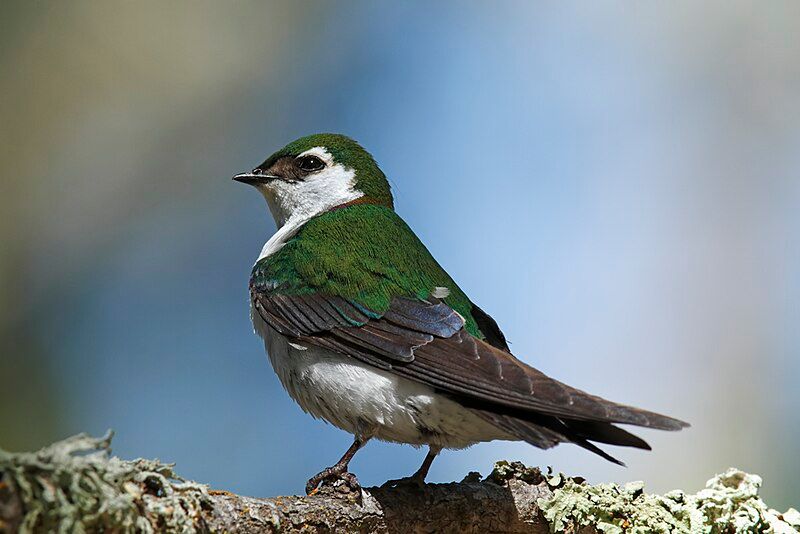
The violet-green swallow is a small bird that is native to North America. It belongs to the swallow family and is an aerial insectivore, meaning it feeds on insects it catches in mid-air.
These birds are found in many areas, from Alaska in the north to Mexico in the south and as far east as Montana and Texas. They are familiar sights in coastal areas, where they can often be seen swooping through the air for their prey.
The birds are small, with a short, forked tail and pointed wings. They are often seen on flights and can reach up to 50 miles per hour. Their plumage is a bright mixture of green, yellow, and violet, making them a colorful addition to the landscape.
| Kingdom | Animalia |
| Phylum | Chordata |
| Class | Aves |
| Order | Passeriformes |
| Family | Hirundinidae |
| Genus | Tachycineta |
| Species | T. thalassina |
3. Green-Winged Teal
The American teal, also known as the green-winged teal, is a species of duck found across an extensive range of North America. It is a widespread species that breeds in northern areas, except the Aleutian Islands.
In the past, this species was thought to be the same as the Eurasian teal but has since been classified as its species. This duck species is easily recognizable due to their bright green wing patches and distinctive call.
They are found in various habitats, from freshwater marshes to open fields. The American teal feeds mainly on aquatic invertebrates like insects, mollusks, crustaceans, and amphibians. During the winter, they migrate to areas with more suitable feeding conditions.
The American teal is an essential wetland ecology species and a famous game bird in many areas.
| Kingdom | Animalia |
| Phylum | Chordata |
| Class | Aves |
| Order | Anseriformes |
| Family | Anatidae |
| Genus | Anas |
| Species | A. carolinensis |
4. Ruby-Crowned Kinglet
The Ruby-crowned Kinglet is a tiny North American bird that belongs to the kinglet family. Its plumage is olive-green, with two white wing bars and an eye ring. The males of the species have a distinguishing feature of a red crown patch that is usually hidden.
It is a passerine bird, which means it is perching and has three toes pointing forward and one toe pointing backward. This species is usually found in woodlands, such as coniferous and deciduous forests, as well as other shrubby habitats.
The Ruby-crowned Kinglet is an active forager, searching for food among foliage and bark. Their diets consist mainly of insects, spiders, and small berries. They are also known to feed on nectar and sap from trees.
During the winter, they can be seen in flocks, foraging for food together. The Ruby-crowned Kinglet is an essential species in North America, as it helps to maintain the balance of its ecosystems.
| Kingdom | Animalia |
| Phylum | Chordata |
| Class | Aves |
| Order | Passeriformes |
| Family | Regulidae |
| Genus | Corthylio |
| Species | C. calendula |
5. Lilac-Crowned Amazon
The Lilac-Crowned Amazon, also known as Lilac-Crowned Parrot, Finsch’s Parrot, or Finsch’s Amazon, is a type of parrot found only in Mexico’s Pacific slopes.
It is a medium-sized parrot, about 10 inches long, characterized by its bright green plumage, maroon forehead, and beautiful violet-blue crown and neck.
This parrot species is often found in areas of thick vegetation, such as dense forests and jungles, where plenty of food and water can sustain them. They are also known to inhabit areas of open savanna and grasslands.
The Lilac-Crowned Amazon is a social bird, living in small flocks of up to 10 individuals and often roosting in hollows in trees. They are omnivorous, and their diet includes fruits, nuts, seeds, insects, and other small animals.
They have a loud and distinct call, which can be heard from far away. The Lilac-Crowned Amazon is currently listed as Vulnerable on the IUCN Red List due to a decrease in their numbers due to illegal hunting and habitat destruction.
Conservation efforts are being made to help protect this species from further decline.
| Kingdom | Animalia |
| Phylum | Chordata |
| Class | Aves |
| Order | Psittaciformes |
| Family | Psittacidae |
| Genus | Amazona |
| Species | A. finschi |
6. Mitred Parakeet
The mitered parakeet, also known as the mitered conure, is a parrot species belonging to the subfamily Arinae of the family Psittacidae. This species is native to Argentina, Bolivia, and Peru but has also been introduced to Uruguay, where it has become established.
This species is widespread in aviculture and is often kept as a pet. The mitered parakeet is known for its colorful plumage and vibrant personality. It has a distinctive green body, red forehead, and yellow breast.
It also has a red patch and blue primary flight feathers on each side of its head. These birds are intelligent and social and can be taught to talk and do tricks. The mitered parakeet lives in large flocks in the wild, but it is also seen alone or in pairs.
Its natural habitat is open woodlands, savannas, and cultivated areas in its range. It feeds mainly on seeds, fruits, flowers, and nectar. In captivity, the mitered parakeet needs an enclosure at least 2m tall to flap its wings and fly around.
It needs a large variety of toys and perches to keep it entertained and should be given a variety of foods to keep it healthy. These birds are known to be very affectionate and loyal to their owners and can be very talkative and entertaining.
| Class | Aves |
| Order | Psittaciformes |
| Family | Psittacidae |
| Genus | Psittacara |
| Species | P. mitratus |
7. Green Heron
The green heron is a small species of heron that is native to North and Central America. Its scientific name, Butorides virescens, is derived from Middle English and Ancient Greek roots.
The genus name Butorides comes from the Middle English word butor, which means “bittern,” and the suffix -rides, which is used to form the names of animals and plants that resemble a given species.
The species name, virescens, is Latin for “greenish,” which is an apt description of the bird’s coloration. Green herons are approximately 24 cm (9.4 in) in length and have a wingspan of 45 cm (17.7 in). They have a dark green back, gray chest, and white belly.
Their necks are long and slender, and their bills are long and sharp. Green herons feed mainly on fish but can also be seen eating amphibians, insects, and small rodents. They usually hunt by standing still in shallow water and waiting for their prey to approach.
Green herons are found in various wetland habitats across North and Central America. These include shallow wetlands, streams, rivers, ponds, lakes, and marshes. They are solitary birds but can sometimes be seen in small groups when searching for food.
They usually nest in small colonies, usually in trees near water. The International Union for Conservation of Nature (IUCN) considers the green heron a species of most minor concern. Despite this, their population is declining due to habitat loss and human disturbance.
It is essential to protect their natural habitats to ensure this species’ survival.
| Kingdom | Animalia |
| Phylum | Chordata |
| Class | Aves |
| Order | Pelecaniformes |
| Family | Ardeidae |
| Genus | Butorides |
| Species | B. virescens |
8. Rose-Ringed Parakeet
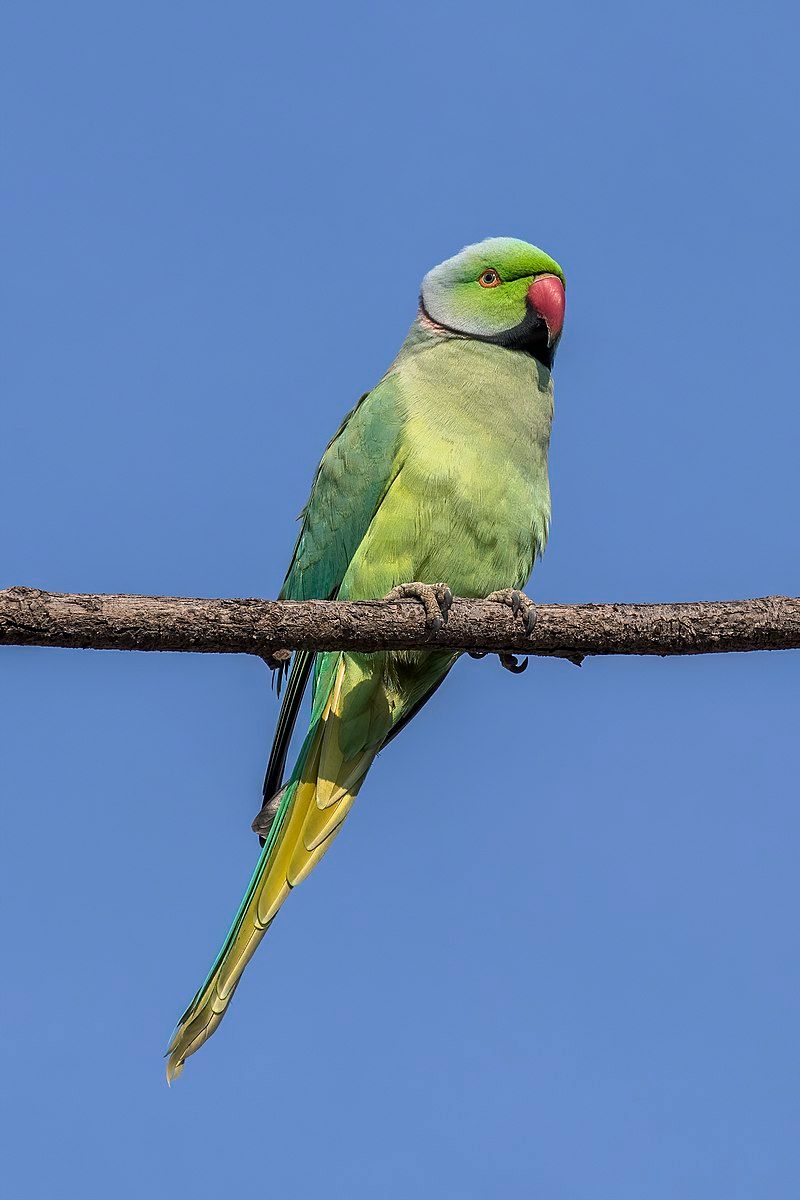
The rose-ringed parakeet is a parrot species native to parts of Africa, the Middle East, and South Asia. Various names, such as the ringneck or Kramer parrot, know it. It belongs to the genus Psittacula and is part of the Psittacidae family.
This type of parrot is medium-sized, typically measuring between 18 and 22 inches in length. Its body is predominantly green, with a black ring around the neck and a pink or yellow band around the wings.
It has a long tail, a curved beak, and a pink or yellow beak patch. The rose-ringed parakeet is a highly adaptable species, and it can be found in various habitats, from forests to urban areas. It is an omnivore, and its diet includes seeds, fruits, nuts, and insects.
It is also an excellent mimic and can learn to imitate human speech. The rose-ringed parakeet is a popular pet, and it is also a famous aviary bird. It is easy to breed in captivity, and it can live up to 30 years in its natural habitat.
It is a social bird that can be kept in pairs or in small flocks. This species is also a great performer, as it can be taught to do tricks and to fly through hoops.
The rose-ringed parakeet is an important species in the avian world, and it is important to protect it from human activities and habitat destruction.
By doing so, we can ensure that this species and its many fascinating behaviors remain a part of our world for years.
| Kingdom | Animalia |
| Phylum | Chordata |
| Class | Aves |
| Order | Psittaciformes |
| Family | Psittaculidae |
| Genus | Psittacula |
| Species | P. krameri |
9. Calliope Hummingbird
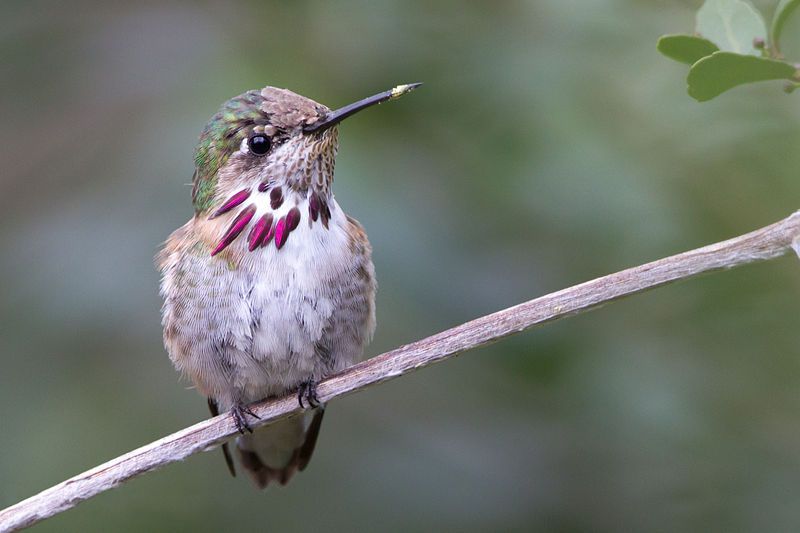
The calliope hummingbird is a tiny species of bird that is native to North America. The bird’s breeding range is mainly concentrated in the western parts of the continent, from California to British Columbia.
During winter, the calliope hummingbird migrates to more southern regions, including the Southwestern United States, Mexico, and Central America.
This enables the bird to escape the colder weather of its breeding range and take advantage of the warmer temperatures in the south. The calliope hummingbird is the smallest bird native to the United States and Canada.
Its distinctive features include a long, slender bill and white-tipped outer tail feathers. The male calliope hummingbird has a bright green back and head with dark brown wings and tail.
The female has a more muted brownish-green back and head, with slightly paler wings and tail. The calliope hummingbird feeds on a variety of insects and nectar from flowers. It typically forages in open areas like meadows and hovers in front of flowers to feed.
During the breeding season, the male will make a distinctive humming noise to attract a mate. The calliope hummingbird is a species of particular concern due to its small population and limited range.
Conservation efforts have been undertaken to protect the species, such as habitat restoration and protection of its wintering grounds. With continued efforts, the calliope hummingbird population should remain stable for years.
| Kingdom | Animalia |
| Phylum | Chordata |
| Class | Aves |
| Clade | Strisores |
| Order | Apodiformes |
| Family | Trochilidae |
| Genus | Selasphorus |
| Species | S. calliope |
10. Broad-Tailed Hummingbird
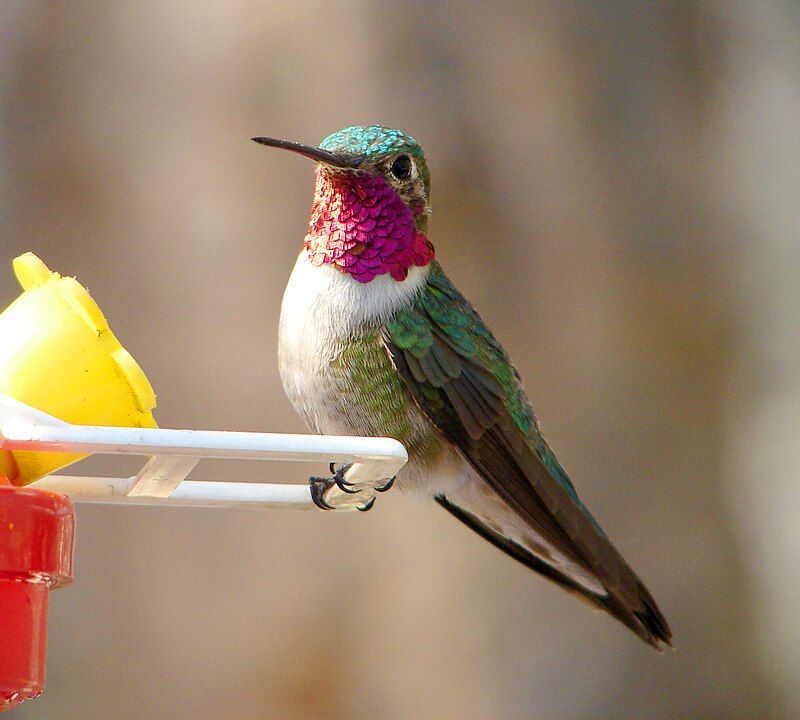
The broad-tailed hummingbird is a bird species found throughout the highlands of North and Central America. It is a medium-sized bird, measuring approximately 4 inches long, with a 3.5 to 5 inches wingspan.
It is characterized by its broad, forked tail and brightly colored feathers, which are typically shades of green, blue, and red. This species is commonly found in the western United States and western Canada, ranging from British Columbia in Canada down to Mexico and Guatemala.
It inhabits various habitats, including woodlands, shrublands, and mountain meadows.
It is a migratory species, with some populations traveling south for the winter while others remain in their northern habitats year-round. The broad-tailed hummingbird feeds primarily on nectar from flowers but will also take small insects and spiders.
It is a territorial bird, and males can often be seen displaying their bright feathers to woo potential mates.
Females build their nests in trees or shrubs and lay between two and four eggs. In recent years, the broad-tailed hummingbird has seen a decline in its population due to habitat destruction and other human activities.
As such, the species is now listed as vulnerable by the International Union for Conservation of Nature. Efforts are being made to protect its habitats and ensure the species does not become endangered.
| Kingdom | Animalia |
| Phylum | Chordata |
| Class | Aves |
| Clade | Strisores |
| Order | Apodiformes |
| Family | Trochilidae |
| Genus | Selasphorus |
| Species | S. platycercus |
11. Costa’s Hummingbird
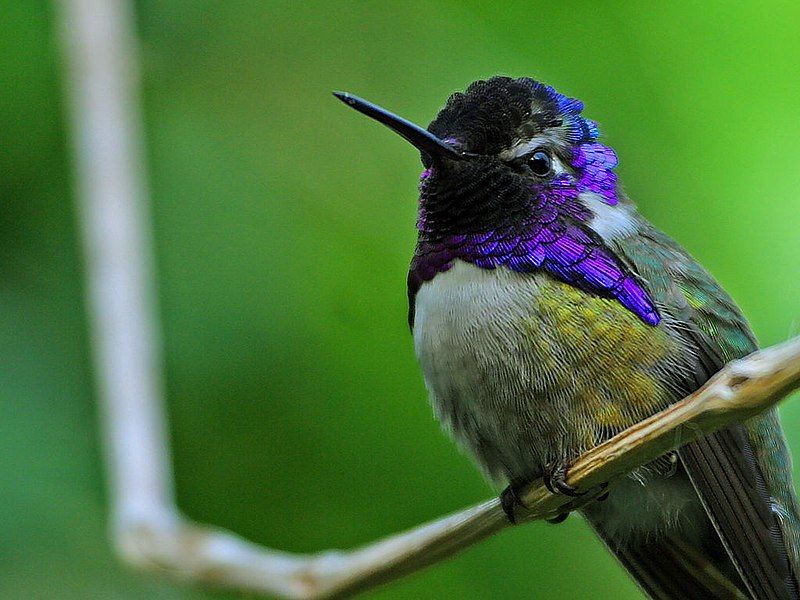
Costa’s hummingbird is a beautiful species of bird found in the Trochilidae family. It is native to the arid regions of the southwest United States and northwest Mexico.
During winter, the Costa hummingbird migrates to western Mexico, where it finds a more suitable climate for its needs. This small bird can easily be identified by its bright green feathers, short, straight beak, and distinctive red forehead.
Its small size makes it one of the smallest species of hummingbirds. It feeds on nectar from flowers as well as small insects. It has a unique call that is often heard during the mating season.
The Costa hummingbird is an essential species in its native range, and humans need to understand the importance of conserving its natural habitat.
| Kingdom | Animalia |
| Phylum | Chordata |
| Class | Aves |
| Clade | Strisores |
| Order | Apodiformes |
| Family | Trochilidae |
| Genus | Calypte |
| Species | C. costae |
12. Green Jay
The green jay is a New World jay commonly found in Central America. It is a medium-sized bird, measuring around 27 cm in length, and its coloration can vary across its range.
The green jay typically has a blue and black head, green wings and mantle, a bluish-green tail, a black bill, yellow or brown eye rings, and dark legs.
This species of jay is often noticed for its bright and colorful plumage, which stands out against the surrounding foliage of its natural habitat.
The bird is known for its adaptability to different environments and is commonly found in various habitats such as forests, scrubland, woodland, and gardens. The green jay is a friendly bird often seen in small flocks, searching for food.
They are omnivorous and feed on various items such as fruits, seeds, insects, and other small animals.
| Kingdom | Animalia |
| Phylum | Chordata |
| Class | Aves |
| Order | Passeriformes |
| Family | Corvidae |
| Genus | Cyanocorax |
| Species | C. luxuosus |
13. Nanday Parakeet
The Monday parakeet is a species of parrot native to South America. It is considered medium-sized compared to other parrot species and is mainly covered in green feathers. Depending on the region, this species is also known as the black-hooded parakeet or Monday conure.
Nanday parakeets are Neotropical parrots, meaning they are found in the tropics of the Americas. They are found in continental South America, from southern Colombia to central Argentina. They inhabit a variety of habitats, from dry forests to wetlands.
Nanday parakeets are social birds that travel in flocks of up to 20 individuals. They are usually seen in areas such as grasslands and agricultural fields. Nanday parakeets feed on seeds, fruits, grains, and nuts. They also eat insects and other small invertebrates.
Nanday parakeets are popular as pets due to their attractive appearance and intelligence. They are known to be very vocal and can learn to mimic human speech. They are also known to form strong bonds with their owners.
| Kingdom | Animalia |
| Phylum | Chordata |
| Class | Aves |
| Order | Psittaciformes |
| Family | Psittacidae |
| Genus | Aratinga |
| Species | A. nenday |
14. Green-Cheeked Parakeet
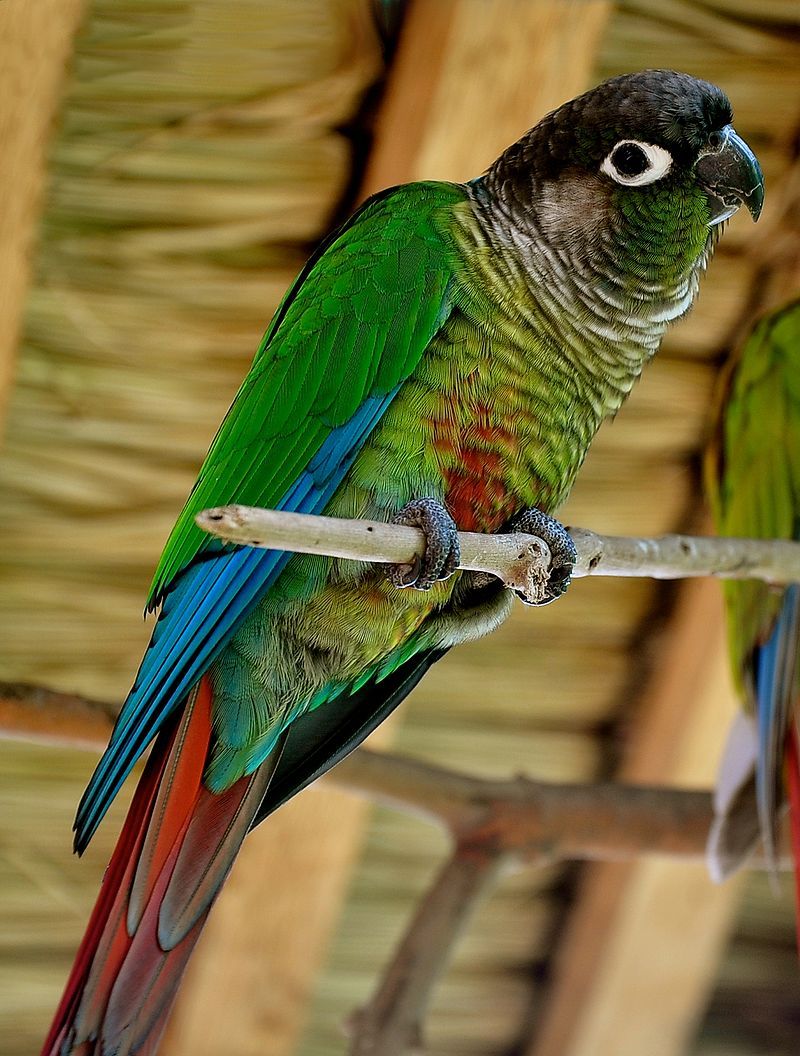
The green-cheeked parakeet is a species of bird found in South America. It belongs to the subfamily Arinae of the family Psittacidae, which is a family of parrots that are native to both Africa and the New World.
This species is native to Argentina, Bolivia, Brazil, and Paraguay. It is also known as the green-cheeked conure in aviculture, which is the practice of keeping and breeding birds. This species is relatively small, ranging from 18 to 22 cm.
Its feathers are mostly green, with a grayish-white belly and bright blue feathers on its wings. It also has a very distinct bright green cheek patch. The diet of the green-cheeked parakeet consists of fruits, nuts, vegetables, and some insects.
It is an active bird and loves to play and explore its environment. It can be taught to talk in captivity, and with proper care and attention, it can make an excellent companion for many years.
| Kingdom | Animalia |
| Phylum | Chordata |
| Class | Aves |
| Order | Psittaciformes |
| Family | Psittacidae |
| Genus | Pyrrhura |
| Species | P. molinae |
15. Jandaya Parakeet
The Jandaya Parakeet, also known as the Jenday Conure, is an exotic bird native to wooded habitats in northeastern Brazil. Its most distinctive features are its colorful plumage and its small size.
The bird has a green back and wings, a reddish-orange body, a yellow head and neck, orange cheeks, and a black bill.
Its vibrant coloration is part of what makes it so appealing to bird enthusiasts. The Jandaya Parakeet is an active and social bird that needs plenty of exercise and stimulation. In the wild, they live in flocks and forage for food such as fruits, seeds, and nuts.
Domestically, they require plenty of space and an enriched environment, with plenty of toys, perches, and activities to keep them occupied.
They are also very vocal birds, with loud calls and a tendency to vocalize when excited. The Jandaya Parakeet is famous, particularly for bird enthusiasts who appreciate its vibrant colors and friendly personality. With proper care, they can make excellent companions.
They require a diet of fresh fruits and vegetables and plenty of exercise and enrichment. They can live up to 25 years or more with the proper care and attention.
| Kingdom | Animalia |
| Phylum | Chordata |
| Class | Aves |
| Order | Psittaciformes |
| Family | Psittacidae |
| Genus | Aratinga |
| Species | A. jandaya |
16. New World Warblers
The New World warblers, also known as wood-warblers, are a family of small, brightly colored birds found exclusively in the Americas. They are part of the Parulidae family and have no close relatives amongst the Old World or Australian warblers.
These birds are passerine, which means they have three toes on each foot and are adapted for perching.
They are generally small and can be identified by their often colorful plumage. The New World warblers are found across the Americas, inhabiting many habitats. They can be seen in open areas, such as grasslands and scrubs, and urban areas.
They feed on insects and invertebrates, gleaning from vegetation or capturing in flight.
While they are generally solitary birds, some species form small flocks during migration or in winter. The Parulidae family includes over one hundred warbler species, split into five distinct genera.
These genera include wood warblers, water thrushes, ovenbirds, and hybrid warblers. Each genus has its distinct characteristics and behaviors.
For example, the wood-warblers are typically brightly colored and have distinct songs, while the water thrushes are dark gray and usually found near water.
The ovenbirds are named for their domed nests, and the hybrid warblers result from interbreeding between two different warbler species. The New World warblers are unique birds exclusive to the Americas.
They can be identified by their small size and often colorful plumage and are found in various habitats. They are part of the Parulidae family, which includes over one hundred species of warblers divided into five distinct genera.
| Kingdom | Animalia |
| Phylum | Chordata |
| Class | Aves |
| Order | Passeriformes |
| Family | Parulidae |
Conclusion
The presence of green birds in California is a testament to the state’s rich biodiversity and diverse ecosystems.
From the lush forests of the northern regions to the coastal wetlands and deserts of the south, these avian inhabitants contribute to the intricate tapestry of California’s natural heritage.
Studying and conserving these green birds offers insights into their unique adaptations and behaviors and underscores the importance of preserving their habitats for future generations.